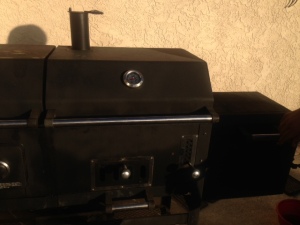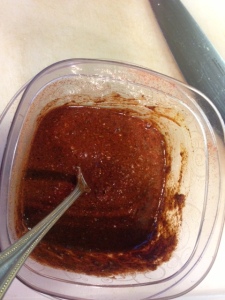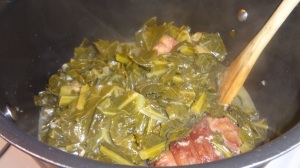I spent the holiday season at my parents’ home cooking up a storm! Who could not be motivated to throw down in the kitchen when you’re surrounded by eager taste testers, fellow culinary enthusiasts, and quality ingredients!
It has been one of my recent goals to develop a great recipe for andouille sausage. For those of you not familiar with andouille, it is a coarse-textured pork sausage with a medium fat content. Its flavor profile comes from a lot of fresh garlic, paprika, and slow smoking. I remember spending a few summers during high school and college with my grandmother in rural Louisiana and having the best, freshly smoked andouille sausage from the mom-and-pop smokehouse in town. The quality and flavor was superior to any commercial andouille sausage sold at the local grocery store. So much so that each summer, I would stock up and pack 20 pounds of smoked tasso and andouille in my carry on suitcase to take back home!! (No lie)
Lucky for me, my dad’s a semi-pro at sausage making – he’s been making the best boudin in the world (totally unbiased!) for as long as I can remember. So he and I took a trip to the meat monger, pulled out the meat grinder, and got to work in the kitchen. The final product was delicious and reminded us of the andouille from the mom-and-pop smokehouse. If you’ve got the equipment, time, and are up for a culinary adventure, please try our recipe! If not, well… if you’re family or a friend, at least you know who to call for some amazing andouille! 🙂
TIP!: This recipe is for medium spice/heat level andouille. For hot/spicy andouille, double the amount of cayenne pepper. Keep in mind that if your sausage is hot, every dish you use it in will be hot as well.
TIP!: It’s always important to taste your sausage mixture after seasoning because you cannot adjust the seasoning after it’s stuffed and cured. Make a test patty after you season your meat, cook the patty thoroughly in a frying pan, and taste! Adjust your seasoning, if necessary.
Andouille Sausage
Seasoning Mixture – Per pound of meat mixture
Cure Note: The addition of nitrate cure salt is crucial for any sausage that is dried or smoked at low temperatures (40°F – 140°F). Nitrates prevent the growth of microorganisms, particularly Clostridium botullinum – the cause of botulism. This microbe forms spores that grow well in low-oxygen environments and at temperatures of 40°F – 140°F, which is the type of environment created when smoking meat at low temperatures. There is controversy regarding the health risks and benefits of nitrates in cured meats and I suggest that you read up on both points of view before curing any meats.
- 2 tbs. minced, fresh garlic
- 1 tsp. paprika
- 1 tsp. black pepper
- 3/4 tsp. kosher or sea salt
- 1/2 tsp. dried thyme
- 1/4 tsp. cayenne
- 1/5 tsp. instacure #1 (it’s 1 tsp. per 5 lbs. of meat, so estimate if you’re making less than 5 lbs.)
- 2 tbs. water
Mix all of your seasonings and herbs together with water to create a paste. Leave minced garlic as is.
Meat Mixture
- 3 parts of lean pork butt or pork shoulder – skin removed
- 1 part of pork fat (ask your butcher for fat trimmings)
Sausage Casings Note: I greatly prefer natural hog casings to synthetic casings. They have a much better bite after cooking your sausage. This was the first time I used pre-tubbed casings, which are more expensive but they do not need to be cleaned as you would natural hog casings. I would recommend the pre-tubbed casings for this reason – if you’ve ever cleaned natural hog casings or chitterlings, then you’d understand!
Sausage Making:
- Use a meat grinder with the coarsest blade/plate and grind all the fat and 2/3 of your pork butt or shoulder. Your meat and fat should be very cold to assist the grinding process and keep your product coarse.
- Freeze the remaining third of the pork for at least 1 hour. Freezing your meat will make it easier to cut. Cut the meat into 1/4 inch to 1 centimeter cubes, and add to your ground meat.
- Add the seasoning paste and minced garlic to your meat mixture and mix well with your hands.
- Load your casings on your sausage stuffer and get to stuffing!! If using an electric dual grinder and stuffer (as we used, below), remove any grinding blades/plates before securing your stuffer nozzle to prevent further grinding of your meat. Make links as long or as short as you wish.
- Place the sausage in a loosely covered pan in the fridge overnight (12 – 18 hours) to cure.
Sausage Smoking:

The smoker. The sausage is in chamber on the left, and the smoke is generated in the small chamber on the right.
You want to smoke your sausage at the lowest temperature possible, given your smoker apparatus. We smoked ours at 120-140°F for 2.5 hours, then raised the temperature to 200°F for 1 hour or until the internal temperature of the sausage read 152°F. We used mesquite briquettes but you can use another kind of wood, if you prefer. To achieve the temperature variation, we simply added additional hot coals to the wood briquettes to increase the temperature. You can also try decreasing the distance between your coals and sausage to increase the temperature, or adjust any vents on your smoker. The most important part about the smoking step is to keep the temperature low. If the temperature is too high, your sausage will cook before it has finished smoking, which will affect the flavor profile (although your sausage will still be super yummy!).

The smoker set up – the smoke chamber. Coals were added, removed, or repositioned to adjust the temperature of the the smoke.
Once your sausage is smoked, it is fully cooked and can be stored in your fridge for up to 3 weeks (the cure is a preservative) or for 6 months in the freezer. But honestly, this sausage is so good it probably won’t linger in the fridge for more than 2 days!
TIP!: If you don’t have the sausage making equipment or a smoker, this recipe makes a very tasty fresh sausage. You can use the seasoning mixture as is (minus the addition of instacure if you’re not smoking your meat) with course ground pork obtained from your trusted butcher. Super easy and tasty!
















